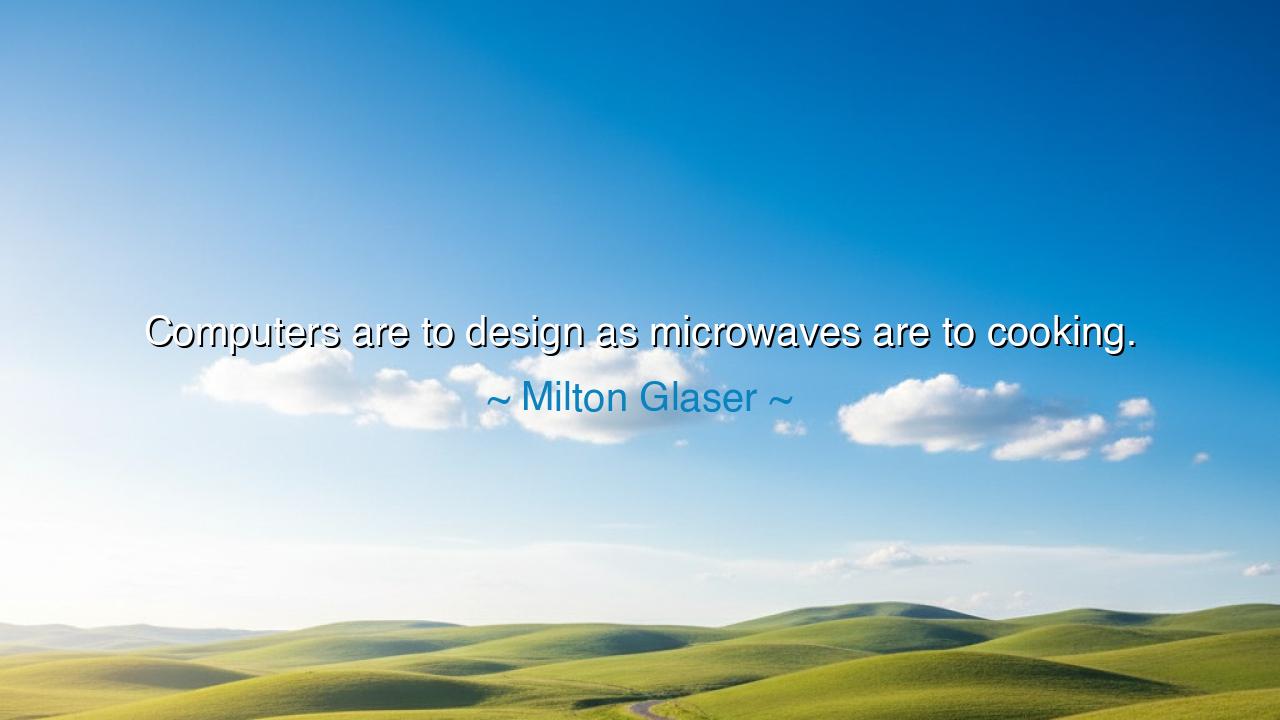
Computers are to design as microwaves are to cooking.






Milton Glaser’s words, “Computers are to design as microwaves are to cooking,” offer a deeply insightful commentary on the relationship between tools and craftsmanship in the realm of art and creativity. Glaser, a master designer himself, uses this analogy to draw a clear distinction between the quick and easy results promised by modern technology and the more thoughtful, deliberate process that true design and craft require. Just as a microwave may offer a quick and convenient meal, but lacks the depth and savor of food prepared with time and care, so too does the computer offer a fast route to design, but may fall short of the artistry and intention that can only come from human hands and vision. The tools may be powerful, but it is the artist who imbues the work with soul and purpose.
In the ancient world, the value of craftsmanship and skill was revered. The Greeks, for instance, celebrated the work of sculptors like Phidias, whose creations, such as the statue of Athena Parthenos, were not just works of art but representations of humanity’s highest ideals—wisdom, strength, and beauty. The process of creation, from the chiseling of marble to the deliberate choice of materials, was seen as an act of devotion and expression. In the same way, the design of a modern graphic or architectural work requires a human touch—a connection between the creator and their materials, whether digital or physical. Computers, while powerful tools, can never replace the intuition, emotion, and vision that come from the designer’s mind, just as a microwave cannot replicate the rich flavors of a meal that has been slow-cooked with care.
The story of Michelangelo and his creation of the David offers another powerful example of this principle. Michelangelo, who worked tirelessly on his marble block for years, didn’t simply see a piece of stone; he saw the human form within it. Every chisel strike was an act of discovery and revelation. Michelangelo’s process was about much more than efficiency—it was about creating something that embodied both human excellence and divine beauty. In contrast, a modern machine could easily mass-produce a replica of the David with the push of a button, but such a replica would lack the soul of Michelangelo’s original. Similarly, design, when reduced to a mere product of technology without the designer’s intent and artistry, risks becoming sterile and unremarkable—just as a microwave meal lacks the nuance and depth of a home-cooked feast.
The ancient Romans, too, celebrated craftsmanship in design, particularly in the fields of architecture and engineering. The Colosseum, the Pantheon, and the aqueducts were all works of both practical engineering and artistic vision, blending functionality with beauty. Vitruvius, the Roman architect, wrote extensively about the importance of proportion, harmony, and aesthetic sensibility in architectural design. These principles were not simply about efficiency or utility—they were about creating structures that connected the human experience with something greater. In much the same way, modern design is not just about the output a computer can generate, but about the emotion, experience, and aesthetic value it conveys. Computers can assist in the process, but they cannot replace the designer’s vision or the emotional connection that comes from the deliberate act of creation.
Today, software can generate impressive designs in a fraction of the time it would take a designer to sketch, paint, or carve by hand. But, as Glaser’s quote suggests, the quickness and efficiency of digital tools can sometimes mask their limitations. The aesthetic power of design is not solely about speed or output; it is about the craft and meaning behind the work. Just as microwaves can deliver a meal in minutes but cannot replace the nurturing care of a chef, computers can produce designs, but the heart of those designs often lies in the artist’s hand. Design, like cooking, is as much about the process as the product, and it is the human connection to that process that gives it value.
As we move further into a world dominated by technology, it is essential that we do not lose sight of the importance of craftsmanship, vision, and human connection. The ancients understood that tools, while powerful, must be used in service of something greater than themselves. The artist or designer must always retain control over their materials and their vision, even when technology is involved. Software can enhance the creative process, but it must never overshadow the humanity that gives design its true purpose.
Lesson for the ages:
The true power of design lies not in the tools we use, but in the intentions and creativity of the designer. Just as the ancients saw craftsmanship as a vital force in shaping society, we must remember that tools, whether physical or digital, must always serve the greater purpose of human expression and connection. While computers and software can assist in the process of design, they should never replace the human touch that gives art its meaning, purpose, and soul.
Practical Action:
In your work and creative endeavors, recognize that tools—whether microwaves or computers—are meant to serve you, not the other way around. Embrace the efficiency and capabilities that technology offers, but never forget that the true power of your creations lies in your vision and your human connection to the work. Take time to engage with the process of creation, whether it is designing, cooking, or building, and allow your creativity and craft to shine through. Just as the ancients revered the artistry of the hand, so too must we continue to honor the deep humanity embedded in the work we create.






AAdministratorAdministrator
Welcome, honored guests. Please leave a comment, we will respond soon